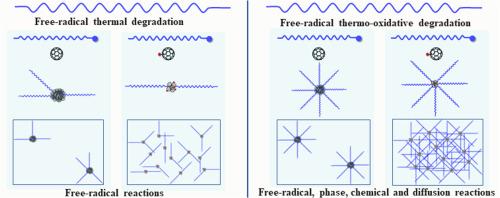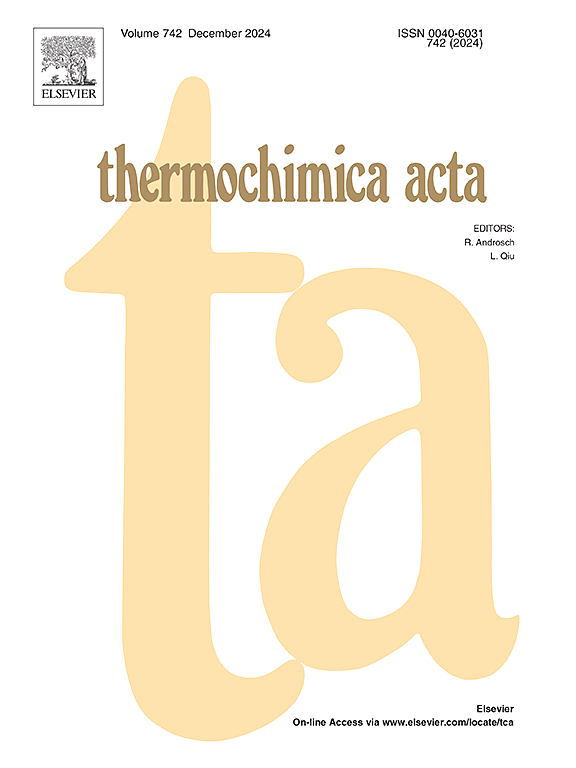Kinetics and mechanism of thermal and thermo-oxidative degradation for high-density polyethylene modified by fullerene and its derivative
IF 3.1
2区 化学
Q2 CHEMISTRY, ANALYTICAL
引用次数: 0
Abstract
To investigate the effect of fullerene (C60) and its iron compound (C60-Fe) on the thermal and thermo-oxidative degradation mechanism of high-density polyethylene (HDPE), the Kissinger method, Flynn-Wall-Ozawa method and Coats-Redfern methods are used. The data of thermal and thermo-oxidative degradation are achieved through the thermogravimetric (TG) analysis, and the trapping free-radical ability and the dispersion of C60 or C60-Fe in matrix are characterized by the electron spin resonance (ESR) and transmission electron microscopy (TEM). C60 and C60-Fe improve effectively the thermal and thermo-oxidative stability of HDPE. In N2, C60 and C60-Fe do not change the degradation mechanism of HDPE, and the degradation rate is determined by the random generation and growth of free-radicals. In air, C60 changes the reaction order (n) of HDPE at the oxidation stage and the degradation mechanism at the random fracture. C60-Fe changes the thermo-oxidative mechanism of HDPE due to the formation of cross-linked network.

富勒烯及其衍生物改性高密度聚乙烯的热降解和热氧化降解动力学与机理
为了研究富勒烯(C60)及其铁化合物(C60-Fe)对高密度聚乙烯(HDPE)热降解和热氧化降解机理的影响,采用了基辛格法、Flynn-Wall-Ozawa 法和 Coats-Redfern 法。热重(TG)分析获得了热降解和热氧化降解的数据,电子自旋共振(ESR)和透射电子显微镜(TEM)表征了 C60 或 C60-Fe 在基体中捕获自由基的能力和分散性。C60 和 C60-Fe 能有效提高高密度聚乙烯的热稳定性和热氧化稳定性。在氮气中,C60 和 C60-Fe 不会改变高密度聚乙烯的降解机理,降解速率由自由基的随机生成和增长决定。在空气中,C60 改变了高密度聚乙烯氧化阶段的反应顺序(n)和随机断裂的降解机理。由于形成了交联网络,C60-Fe 改变了高密度聚乙烯的热氧化机理。
本文章由计算机程序翻译,如有差异,请以英文原文为准。
求助全文
约1分钟内获得全文
求助全文
来源期刊

Thermochimica Acta
化学-分析化学
CiteScore
6.50
自引率
8.60%
发文量
210
审稿时长
40 days
期刊介绍:
Thermochimica Acta publishes original research contributions covering all aspects of thermoanalytical and calorimetric methods and their application to experimental chemistry, physics, biology and engineering. The journal aims to span the whole range from fundamental research to practical application.
The journal focuses on the research that advances physical and analytical science of thermal phenomena. Therefore, the manuscripts are expected to provide important insights into the thermal phenomena studied or to propose significant improvements of analytical or computational techniques employed in thermal studies. Manuscripts that report the results of routine thermal measurements are not suitable for publication in Thermochimica Acta.
The journal particularly welcomes papers from newly emerging areas as well as from the traditional strength areas:
- New and improved instrumentation and methods
- Thermal properties and behavior of materials
- Kinetics of thermally stimulated processes
文献相关原料
公司名称
产品信息
阿拉丁
FeCl3·6H2O
 求助内容:
求助内容: 应助结果提醒方式:
应助结果提醒方式:


